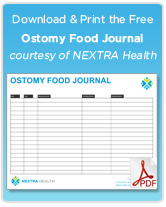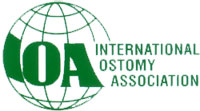Ostomy & A Nutritional Diet – Know Your Guts!
Most folks generally don’t think too much about what/how they eat and how it affects their waste (short of feeling ill or diarrhea). The reasons for this are simple – it’s generally a minor duty or inconvenience in a typical day, just like sleeping or eating or personal hygiene.
When it comes to what foods to eat, one thing is certain: nobody understands how foods affect digestion or how food travels through the body like an Ostomate does.
That’s because for an ostomate, there is no control when a pouch fills with waste and gas without the intelligent management of diet & nutrition. With this in mind, one needs to consider questions about their diet so pouching needs become more predictable and therefore can be handled with optimal health and minimal complications: What makes things move too quickly? What stops things from moving (food blockages)? Are there foods that can’t be digested properly? What causes pouch output to be more liquid or more solid? Which foods create more odors? Which foods produce more gas?
Being able to answer these questions for yourself will make life much easier!
Basic tips about diet and nutrition for ostomy:
Chew Yer Food – It helps digestion and slows your eating down a bit. It’s a good general diet tip anyway; you’ll know more reliably when you’re full so you don’t overeat and swallow less gas-producing air. Like your mother always aid: Don’t talk with your mouth full. You will also have less likely chances for intestinal blockages around the stoma.
Eat Adequate Portions and Do It Often – Avoid overeating in one sitting and avoid skipping meals, both of these activites can result in producing excess gas.
Stay In Shape – Stay in shape and you’ll avoid a lot of stoma problems. Being overweight puts unnecessary pressure on your guts and your stoma.
Drink Lots of Fluids – Fluid loss is especially common in those who have lost much of their large intestine, so drink lots of water.
Make Scheduled Alterations to Diet – When you find foods you can digest well, test trying different types of foods and adding them to your diet one at a time. This way you’ll notice the changes that particular food can cause. Which leads into the next tip…
Monitor Movement – Keep a log of what you eat and when, and then make a note of the condition of your stoma and pouch output. This way you can start to see patterns and determine the best diets with all the foods you like. If you notice a change in pouch output, try a food several times to be sure its a consistent change and you’ll have a pretty good idea of how it affects you.
Foods to Avoid – Food Blockages
Generally it’s accepted that fiber aids digestion, but especially with illeostomy (small intestine), undigested fiberous foods can cause complications and food blockages. So can not checking your food enough. (See the tips above).
Some examples of foods that can cause these blockages are: corn, dried fruit, hotdogs/sausages, pineapple, skins from fruits and vegetables. If you or your child experiences belly cramps, watery stool, a swollen stoma, or nausea it could be a sign of food blockage, consult a nurse and physician.
Foods to Avoid – Odors
Ostomy odor is created by bacteria breaking down certain foods, turning it into odorous waste and also sometimes creating odorous gases. This gas, like the stool, also makes it way into a pouch, filling it with air that must be released to prevent pressure from developing a leak, or worse, a pouch blowout.
While some pouches have integrated filters or can have a filter added to them, it is also a good idea to avoid odor-causing and gas-forming foods. Below are some examples of foods that affect most individuals:
Some foods that do cause odors:
Asparagus, coffee, garlic, prunes, beans, cucumbers, green peppers, radishes, brussel sprouts, eggs, milk, turnips, cabbage, fish, onions, vitamins/certain drugs, alcoholic beverages.
Some foods that help decrease odors:
Buttermilk, parsley, yogurt, cranberry juice, spinach.
Some foods that produce more gas:
Apples, soda, dairy products, onions, asparagus, drinking straws & chewing gum (you’ll swallow more air), melons, beans, mushrooms, corn, broccoli, spinach, nuts, cabbage.
One final note about digestive odors: Another product that may help with gas and odors are Devrom Tablets. Taken up to four times daily, they help control the odors of digestive gases with bismuth subgallate. This is, of course, not meant as a replacement to intelligent dieting, but if certain foods you enjoy make you gassy then a couple of Devrom tablets right before you eat should do the trick.
More Food for Thought – Thickening and Thinning
Some foods will also change the consistency of the stool, and depending on the type and adhesion of a skin barrier you’re using, more liquid can harm the adhesion of the barrier and cause it to leak, never a pleasant experience! Here are some examples of foods, take note how they affect you:
Some foods that will thicken pouch output:
Yogurt, bananas, milk (preferably boiled), creamy peanut butter, breads, cheeses, pastas, potatoes, rice.
Some foods that thin pouch output:
Fruits and fruit juices, chocolate, green beans
When Diarrhea Happens
Sometimes diarrhea happens, which for anyone results in fluid loss and loss of two essential minerals needed for good health: potassium and sodium. Dehydration is always a concern with diarrhea for anyone, and fluid retention can be even more serious for an Ostomy patient. When diarrhea happens, it’s good to get plenty of fluids along with potassium and sodium to stay healthy, so the foods below should be considered:
Some more foods high in potassium:
Milk, Chicken, beef, fish, pork, turkey, lima beans, V8 Juice, apricots, bananas, avocado, tomato juice, potatoes, broccoli, grapefruit juice, oranges and orange juice, watermelon, strawberries.
Foods high in salt:
Salt is definietly not hard to find. Simple table salt will get you sodium, along with most pre-packaged foods, canned soups, and seasonings.
This guide from the University of Pittsburg Medical Center (and the source for some of the data in this article) gives many suggestions on foods that are safe for those with diarrhea and ostomy, along with a beverage recipe to help keep you hydrated and make sure you’re not losing potassium and sodium: http://www.upmc.com/HealthAtoZ/patienteducation/Documents/OstomyNutrition.pdf
Here’s the recipe:
- 1 teaspoon salt
- 4 teaspoons corn syrup
- 1 teaspoon baking soda
- 1 6-oz can of frozen orange juice
- Enough water to make 1 quart of beverage.
Stay Informed and Stay Healthy!
I suggest reading this thorough and useful guide on ostomy and nutrition from UOAA as well. It’s a PDF you access and even save to your computer for reference:
The new online Hollister product guide on Ostomy Guide
When it comes to Ostomy Supplies there is an overwhelming number of options and sizes, patented technologies and brand names. Then you further add to the complexity with HCPCS codes, pouch colors & material selections. Add all of these variations up and you end up with hundreds of product codes to choose from in lists and catalogs overwhelming for consumers, physicians, and nurses.
So anyway I’ve made it a goal of mine to put this information online the best I can in an organized format similar to a tabbed product catalog to make it convenient to find the correct features and codes online. Since Hollister is one of the bigger brand names in Ostomy, I started by doing a product catalog for their products first. Even doing this, there is still no reference point on prices for any of these products, so I’ve linked many of the product codes to the correct product on NextraHealth.com. You can see the new Hollister ostomy catalog here.
I found building this with tabbed navigation and tiny thumbnails to be useful for my own personal reference and I felt other people may find it useful, so it really made the most sense to just put it online.
Of course, if you do find it useful, your feedback would be greatly appreciated, and I’ll add catalogs for the other brands of Ostomy supplies.
See the Hollister Ostomy Product Catalog.

 One of their singers,
One of their singers, 








